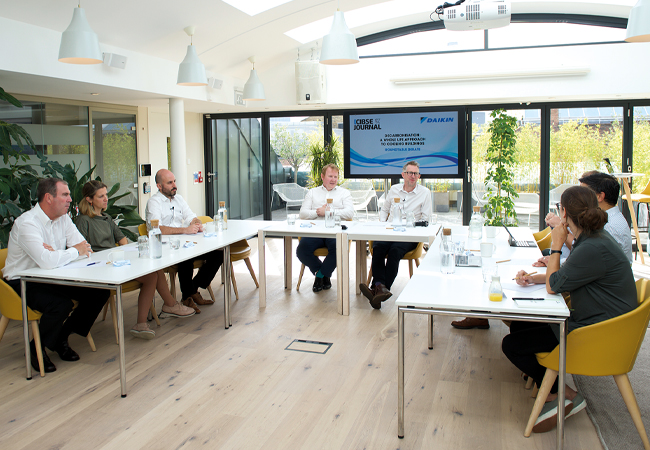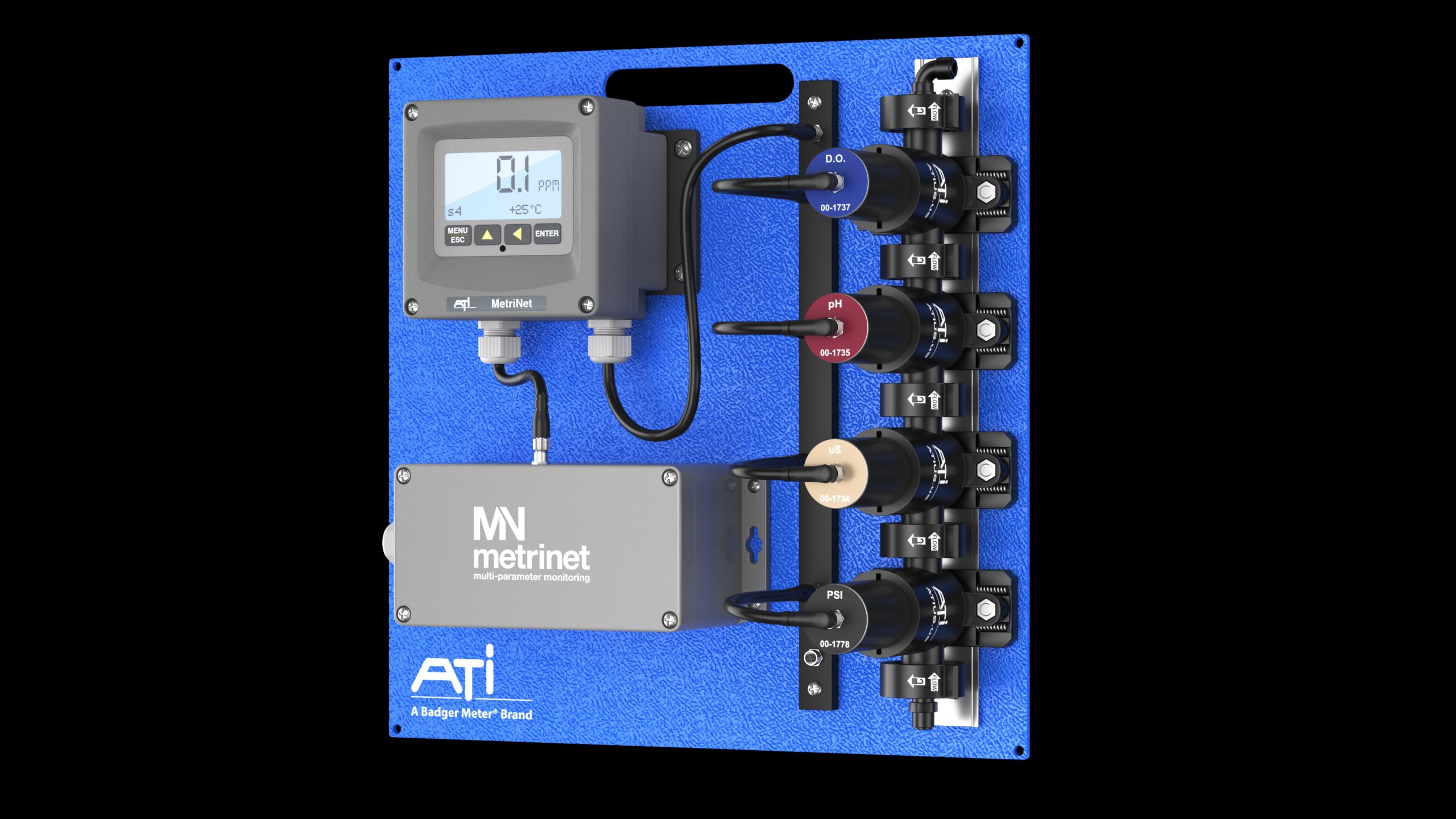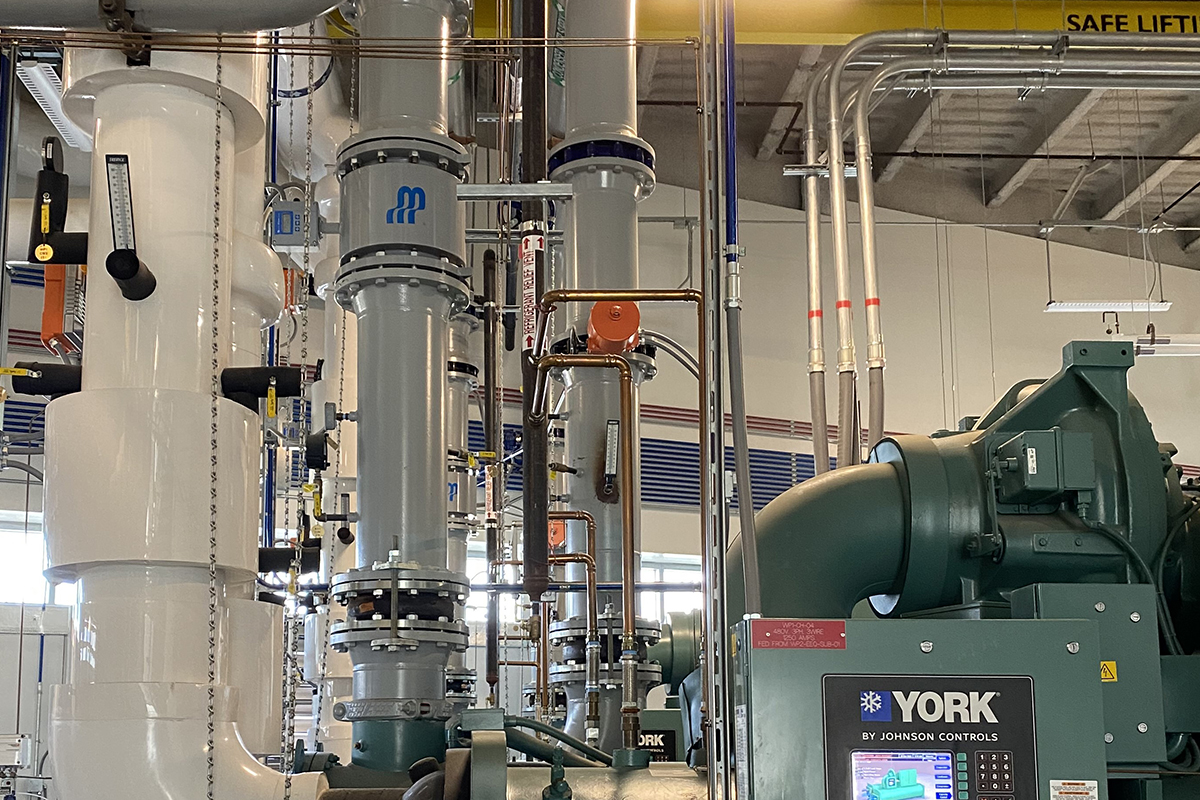
Roundtable sponsor
Industry experts at a CIBSE Journal roundtable on cooling have unanimously agreed that the industry can take big steps towards decarbonisation if new buildings and systems are well designed to take building loads into account.
The event, Decarbonisation: a whole life approach to cooling buildings sponsored by Daikin, looked at the complex challenges and potential solutions to staying comfortable on a warming planet. Refrigerant leakage, the challenges of cooling existing buildings, and embodied carbon were some of the topics debated.
Hugh Dugdale, associate principal at Elementa Consulting, kicked off the roundtable by describing his involvement, as one of the authors, in the TM65.1 addendum, which investigated the embodied carbon impact of heating and hot-water equipment for use in residential buildings. He is also exploring the implications of refrigerant leakage, which can have a huge impact on global warming.
It’s so strange that there’s so little information about refrigerant leakage, yet it’s a controlled substance –Hugh Dugdale
‘It’s so strange that there’s so little information about refrigerant leakage, yet it’s a controlled substance,’ he said. ‘It should be easy to record how much refrigerant is topped up and poured into systems each year, but there’s no central database. We have contacted installers to get this information, but it’s very poorly documented.’
Bianca Laura Latini MCIBSE, senior sustainability engineer at Buro Happold, has also looked at refrigerant leakage and explored what will be available at the F-Gas Regulation phases. She has talked to manufacturers about refrigerant development and making low global warming potential (GWP) refrigerants more feasible for clients. Latini has also done work for Bristol City Council on its heating and cooling policy, and a whole life carbon and cost assessment of seven different systems in commercial and residential buildings was carried out.
Making it clear to clients which refrigerants are most appropriate for their system is very important – Bianca Laura Latin
‘They were all electric, because we started from the premise that they have a net zero carbon city target, and we looked at different kinds of heat pumps versus domestic heating and district heating networks,’ said Latini. ‘The Council was interested to know the feasibility of low-GWP refrigerants. It’s a call to manufacturers to develop low-GWP refrigerants.’
Matteo Dall’Ombra, VRV specialist at Daikin, said refrigerants are key to reducing the carbon footprint of leading air conditioning manufacturers. Daikin has adopted a two-tier strategy for how refrigerants are used and the type of refrigerant specified. Every new product employs the lowest possible GWP refrigerant, which now means the new R-32. This conveys heat efficiently and reduces electricity consumption by approximately 10% compared with air conditioners using refrigerant R-22.
The F-Gas Regulation requires refrigerant top-ups to be recorded, but it’s often challenging to get this information” – Matteo Dall’Ombra
For products that can’t use R-32, Daikin adopts 100% reclaimed refrigerant. Lower GWP systems will require more careful design and consideration, Daikin bundles these measures with the all new R32 VRV system as default. Latini said that engineers would get used to designing with lower GWP refrigerants as their specification becomes common practice.
‘Each refrigerant has different applications,’ said Latini. ‘Making it clear to clients which refrigerants are most appropriate is very important. I don’t think there’s much literacy in the built environment as to which refrigerants should be applied to which scenario. The other big issue is that we don’t know much about refrigerant leakage.’
The F-Gas Regulation requires refrigerant top-ups to be recorded, but it’s often challenging to get this information from firms, said Dall’Ombra. Dugdale agreed: ‘It’s so painful getting that data out. It’s hard to get a consensus on estimating charge, which manufacturers could help with.
‘With a sealed system, such as a heat pump, you know the charge because it’s in the unit. But with a variable refrigerant flow (VRF) system that has pipework installed on site – that you don’t know the length of and the amount of charge within it –a rough estimate on how much is in there must be made. Then a percentage of what is leaking must be calculated, which is difficult because it’s not just liquid filling the pipe. Guidance is required.’
Richard Cobb, net zero carbon associate at Atkins Global, suggested making it mandatory for firms to record information about refrigerant topping up. He suggested using Display Energy Certificates. Dall’Ombra said the ongoing problem is visibility, because this vital information often gets buried in logbooks and is not easily accessible.
Amy Punter, associate director at Hoare Lea and member of the CIBSE Retrofit in Heritage Committee, also suggested a sophisticated leak-detection system linked to a building management system (BMS) that calculates the amount of leakage and automatically records what has been topped up.
CIBSE retrofit in heratige committee
The newly formed CIBSE Retrofit in Heritage Committee is running a series of free webinars, followed by a live event at CIBSE Build2Perform from 29-30 November at London Excel. The next webinar will be on Design Development on Thursday 13 October at 1pm. Find out more about the CIBSE Retrofit in Heritage Committee here.
The newly published standard IEC 60335-2-40 – which allows the use of refrigerants with a lower GWP, while also ensuring a high level of safety regarding flammability – already allows more sophisticated leak-detection systems, said Dall’Ombra, but he agreed that a central database would be very beneficial.
Asked whether recycling refrigerant was an option, Dall’Ombra added: ‘Reclaimed R-32 is currently not as big yet, because it is relatively new and there’s less stock that can be re-used continually. But there’s no doubt there will be a solution in about two years, with even lower GWP for the smaller residential systems.’
Punter argued that the issue isn’t just about refrigerant leakage; the industry should ensure that buildings are performing as intended and are designed well from the start, she said.
Part of the problem is a lack of guidance on how to decarbonise [historic] buildings – Amy Punter
There has been a tripling of energy consumption used for space cooling since 1990, which is putting electricity grids under strain, especially during periods of extreme heat, such as the one experienced in Europe this summer. As a result, space cooling accounted for nearly 16% of the global building sector’s electricity consumption in 2020 (about 1,885TWh)1. The panel agreed that, before calculating how much cooling buildings require, passive measures must be applied to minimise the energy used in cooling equipment.
Cobb highlighted some typical passive measures he employs to help cool existing commercial buildings. Taking a fabric-first approach is the first step, he said. A building’s thermal mass within the fabric is then considered, as well as finding ways to upgrade its U-value.
‘Additional solar shading is key to helping cool a building and we then look at the efficiency of the cooling kit,’ said Cobb. ‘If it’s near the end of life, we look at refurbishing it or installing a new system. If the building’s façade is degraded so much that it needs to be replaced, we would remove the skin, keep the structure if we can, and reclad the building with modern thermal. Historic buildings require a different approach given their façades’ architectural significance.’
Additional solar shading is key to helping cool a building and we then look at the efficiency of the cooling kit” – Richard Cobb
Cobb added that refurbishing cooling plant is preferable to replacing it. By keeping some of the components he wants to limit the amount of total carbon spent. ‘I always look at carbon in terms of currency,’ said Cobb. ‘The industry needs to say, this is what we’re going to do to this building and it will cost you this much carbon for its whole life. If we did this, we could reduce carbon by simply changing the materials.’
Stephen MacLoughlin, regional director, and net zero carbon lead at Faith + Gould, agreed that a fabric-first approach and external shading are powerful passive measures. He suggested that the UK could learn from architecture in hotter countries, which employ straightforward solutions to address solar gain.
Providing comfortable internal conditions for employees when temperatures rise, while also addressing energy efficiencies, will present challenges – Stephen MacLoughlin
MacLoughlin has concerns, though, about the commercial sector and the landlord/tenant situation. Providing comfortable internal conditions for employees when temperatures rise, while also addressing energy efficiencies, will present challenges.
Punter highlighted new guidance by the British Council for Offices that could have an impact on this issue, as it includes relaxing occupant densities in a post-pandemic world. She also mentioned her work with listed buildings dating from the 1400s to the 1960s. There is a real urgency to find ways to decarbonise these buildings, otherwise they will fall into disrepair. Part of the problem, added Punter, is a lack of guidance on how to decarbonise these buildings, which have complex and challenging requirements, and must be assessed case by case.
‘U-value measurement in listed buildings is straightforward; measuring air permeability is the real challenge,’ she said. ‘There is a drive to decarbonise, but I question whether we will we see a shift in what conservation officers will accept. I hope they will be more lenient to allow decarbonisation of heritage buildings and accept cooling measures such as external shading.’
The concept of packing mass into our buildings to save carbon over the long term is doing untold damage in the immediate term” – Ben Gholam
Punter added that the way to sensitively retrofit listed buildings is to share knowledge and push the boundaries.
Beyond cooling equipment, Ben Gholam, structural engineer at Price & Myers, introduced his research and software development on embodied carbon optimisation in building structures. His team has created an ambitious database and identified issues with using concrete to achieve thermal mass in buildings to regulate internal temperatures. (See panel, ‘The trouble with concrete’).
There is a conflict between the desire to have thermal mass in a building – which helps regulate internal temperatures – while also trying to decarbonise, said Ben Gholam. Concrete is used to achieve thermal mass, which is the worst thing to do, he added, given that concrete is high in embodied carbon. ‘We shouldn’t be using concrete at all,’ said Gholam. ‘The concept of packing mass into our buildings to save carbon over the long term is doing untold damage in the immediate term.’ Ground granulated blast-furnace slag (GGBS) has been proposed as a solution, as it’s a waste product from steel production, but about 20% of GGBS is currently produced to replace cement needs and there are supply problems, says Gholam. ‘We need to look at global averages for materials based on the technologies we have and consider minimising the mass of our buildings,’ he said. Latini asked whether the upfront carbon cost of using concrete is lower than the operational savings that the thermal mass of concrete provides over the average 60-year life of the building. From a structures perspective, it makes little difference, Gholam replied, as the embodied carbon is set once the structure is built and the damage is done. He went on to say: ‘If your building is designed well using limited amounts of steel, with timber and other low carbon materials for the building’s mass, that can work very well for embodied carbon and circularity; they go hand in hand.’ The trouble with concrete as thermal mass
With a predicted tripling in energy used to cool buildings by 2050, it is essential building services engineers take a holistic approach and collaborate with other engineers and manufacturers to find solutions. The roundtable demonstrated how a meeting of minds from across the sector can stimulate original thinking that might just speed our journey to low carbon cooling
References:
1 IEA, Cooling tracking report, Nov 2021 www.iea.org/reports/cooling





